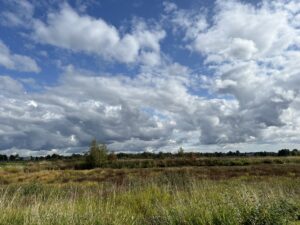
I visited the land on August 8th from about 1:30 to 4:00 pm. The temperature was 20 degrees and cloudy. I mainly looked at the other side away from agricultural land.
The Garden City Lands is a large, open space located in Richmond, BC, within the Greater Vancouver area. It encompasses approximately 55 hectares (136 acres) and is situated on the eastern edge of Richmond’s city center, bordered by Garden City Road to the west, Westminster Highway to the north, and No. 4 Road to the east.
Topography: The land is predominantly flat, typical of much of Richmond, which is located on Lulu Island in the Fraser River delta. This flat terrain makes it a unique open space within the urban setting of Richmond.
Vegetation: The Garden City Lands primarily consists of grasslands, with large sections of the area classified as wetlands. A mix of native grasses, sedges, and other wetland vegetation characterizes these wetlands. The area also includes some patches of scrub vegetation, with scattered trees and shrubs. The presence of wetlands is a significant feature, providing habitat for various bird species and other wildlife.
Designation: The Garden City Lands is designated as an “Agricultural Land Reserve” (ALR). Despite its designation, the site is managed by the City of Richmond.
I observed that there were many types of mosses on the land, and they all had a unique appearance and were easy to distinguish. This made me have some interesting questions.
What are the different species of mosses present in The Garden City Lands, and how does species diversity vary across different microhabitats within the area?
How do mosses in The Garden City Lands interact with other plant species (e.g., facilitating the growth of certain grasses or inhibiting others) and with local fauna (e.g., as nesting material for birds or habitat for invertebrates)?
Moss Reproduction and Dispersal: What are the primary methods of reproduction and dispersal for mosses in The Garden City Lands, and how effective are these methods in maintaining moss populations in the face of environmental changes?
Hi, welcome to the field part of the course. Sounds like you have a good study site. As you work through the next few modules you will continue to refine your ideas. Remember to look for gradients within your site. Your first question has potential if you can define the gradient better.